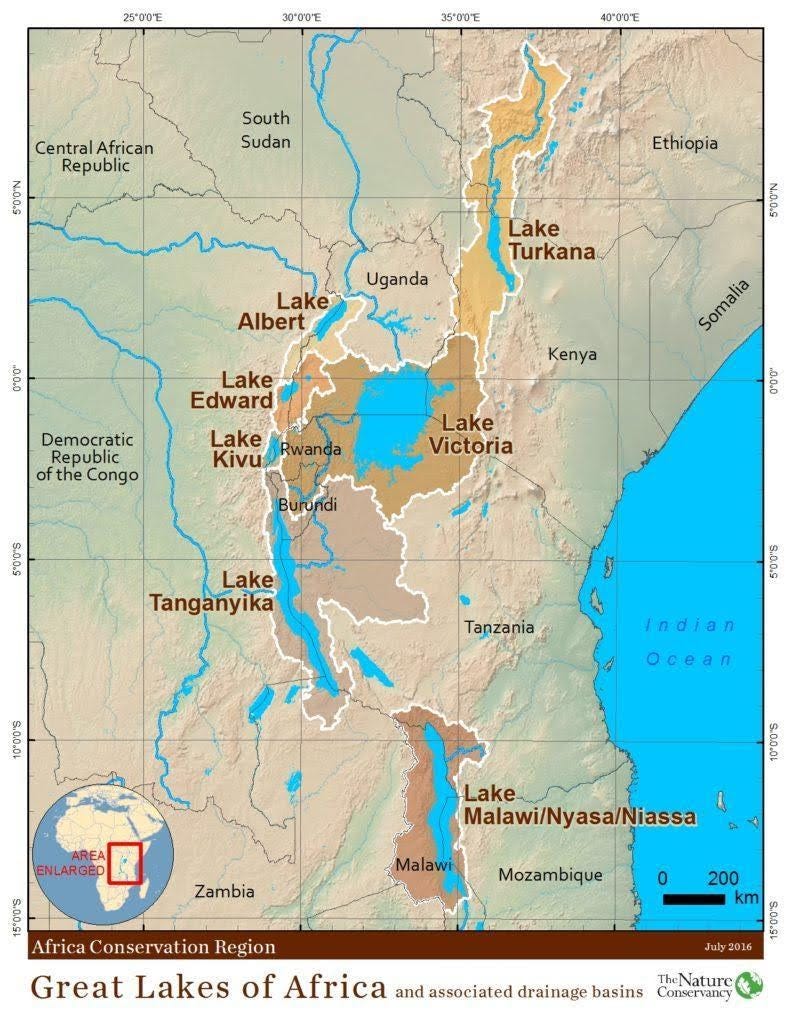The AGS Globe: Africa’s Great Lakes: Where Tectonics, Water, and Life Converge
The American Geographical Society's Weekly Newsletter for July 15, 2025
Welcome to new readers of the American Geographical Society’s weekly, the AGS Globe! The Globe aims to inform and inspire the public with articles about the realms of geography and geospatial as well as exciting opportunities and news from our network. Our pieces fall under four categories: Exploring the World, Championing Geography, Mapping the News, and EthicalGEO. As the world revolves, geography evolves. The mission of the AGS Globe is to bring our storied legacy of exploration and thought leadership into the frontiers of the future.
Africa’s Great Lakes: Where Tectonics, Water, and Life Converge
Most people know the Nile River, but few know its headwaters! In the heart of East Africa lie the African Great Lakes (AGLs), a landscape carved by shifting tectonic plates, punctuated with deep rift valleys, and overflowing with expansive freshwater lakes. Here, the beginning of the Nile is nurtured by Lakes Victoria, Albert, and Tanganyika. This region not only safeguards the Nile River's origins, but also the forces that make it so vital.

The origin of the AGLs can be traced back approximately 12 million years, when tectonic plates in Eastern Africa shifted northeastward and forged the deep rift valleys that would eventually fill with water. The AGLs form part of the Rift Valley lake system that includes seven major lakes: Victoria, Tanganyika, Malawi, Turkana, Albert, Kivu, and Edward. However, the majesty of the region was not only formed through tectonic movement. Lake Victoria was formed through the uplifting of the rifts around it, which created a depression that was filled by surrounding rivers.
These lakes are not only expansive in size, but are globally significant in both scale and impact. Some of them have even set global records: Lake Victoria is the world’s second-largest freshwater lake by surface area, while Lake Tanganyika is both the world’s second-deepest and second-largest by volume.
Together, the AGLs contain over 25% of the world’s unfrozen surface freshwater and serve as the headwaters for three of Africa’s largest rivers: the Nile, the Congo, and the Zambezi. They support unique ecosystems, including hosting over 10% of the world’s freshwater fish species - many of which are found nowhere else. The lakes cover a combined area of roughly 53,455 square miles (138,447 km²), spanning ten countries: the Democratic Republic of Congo, Burundi, Ethiopia, Kenya, Malawi, Mozambique, Rwanda, Tanzania, Uganda, and Zambia. But their importance goes far beyond size. More than 62 million people depend on these waters for drinking, food, transport, and their livelihoods. Fisheries and aquaculture alone contribute 9% of the region's agricultural economy.
However, the AGLs are facing mounting environmental pressures. Since the last century, overuse, pollution, invasive species, agricultural runoff, and habitat degradation have significantly altered these ecosystems. Most of the lakes rely primarily on rainfall for water input (excluding Lakes Albert and Turkana) while losing large volumes through evaporation. This makes them particularly vulnerable to climate change because it disrupts rainfall patterns, intensifies droughts, and reduces agricultural productivity. Birth rates in the region remain among the highest globally, intensifying challenges related to food insecurity and water scarcity. As a result, more people have migrated toward lake regions in search of more reliable resources, further straining these already fragile ecosystems. Despite these challenges, opportunities in agriculture, hydropower, industry, tourism, and natural resource development are growing, bringing investment and local employment. However, without sustainable planning, such growth risks further degrading ecosystems already under pressure.
Managing these transboundary lakes is complex, as they span multiple nations that often lack cohesive regional coordination. Even where institutions like the Lake Tanganyika Authority or the Lake Victoria Basin Commission exist, efforts are hindered by limited funding and weak enforcement capacity, making effective lake management difficult.
The African Great Lakes are more than geographic landmarks; they are tectonic archives, hydrological engines, and lifelines for millions. Their future depends on recognizing the geographic and ecological forces that shaped them and developing cooperative strategies for sustainable use.
Sources:
ACARE (2025). The African Great Lakes. https://www.agl-acare.org/resources/the-african-great-lakes/
Lawrence, T. J., Achieng, A. O., Chavula, G., Haambiya, L. H., Iteba, J., Kayanda, R., ... & Smith, S. (2023). Future success and ways forward for scientific approaches on the African Great Lakes. Journal of Great Lakes Research, 49(6). https://doi.org/10.1016/j.jglr.2023.102242
Plisnier, P. D., Kayanda, R., MacIntyre, S., Obiero, K., Okello, W., Vodacek, A., ... & Lawrence, T. (2023). Need for harmonized long-term multi-lake monitoring of African Great Lakes. Journal of Great Lakes Research, 49(6), Article 101988. https://doi.org/10.1016/j.jglr.2022.01.016
The Nature Conservancy (2025). African Great Lakes Atlas. https://www.maps.tnc.org/AfricanGreatLakes/MapSeries/index.html?appid=a1bb9dcb40a64ad7a3066936be91103c
Did you enjoy reading this? Support the American Geographical Society today with a donation of $50 to help us support Geography education.
REGISTRATION FOR THE FALL SYMPOSIUM IS LIVE! Register now through September 17 for a special Early Registration discount. AGS is gathering innovators and leading voices from business, government, academia, and the non-profit world to share ideas about how artificial intelligence paired with geospatial technology promises to build a brighter future at our 2025 Fall Symposium, GEOGRAPHY 2050: The Future of GeoAI and the Planet, Nov. 20 & 21, 2025, at Columbia University in New York City.
Participate in Geography 2050: Click the links if you’d like to be considered as a contributor with a Lightning Talk or Exhibition Poster.






